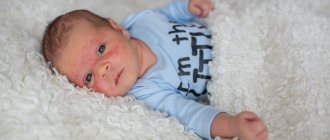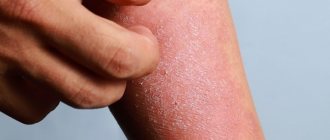Last update: 03/03/2021
The buttocks and thighs are one of the most common locations of skin diseases in children. Dermatitis on a child’s bottom can occur for a variety of reasons, ranging from an incorrectly selected diaper size to an allergic reaction to powder or cream. Although dermatitis can be caused by a variety of factors, most types present with the same basic symptoms: severe redness in the affected area, burning, itching and increased sensitivity of the skin. Children with this disease become restless and moody, sleep poorly and have a decreased appetite.
What increases the likelihood of disease?
- skin damage in the perianal area
- poor hygiene
- poor living conditions and overcrowding at home
- atopic dermatitis
- poor nutrition
- chronic dialysis - the need for blood purification procedures due to kidney failure
The main cause is skin infection with group A streptococcus (GAS).
This microbe can also cause acute tonsillopharyngitis (tonsillitis), scarlet fever, acute otitis media, pneumonia, meningitis, and other skin infections (impetigo, etc.)
PID can also be caused by streptococci of other groups (B, C, G), Staphylococcus aureus, and fecal enterococcus (Enterococcus faecalis).
By the way, group A streptococcus normally does not live on the skin of the perineum, but it can easily get there from other areas from the hands. Infection is also possible through toilet seats, in a common bath, or through the air. For enterococcus, infection of the skin directly from the intestines of the child is typical.
It has been noted that PID often occurs if a child or someone close to him has recently suffered from streptococcal pharyngitis/sore throat. It happens that pharyngitis has already passed, the microbe has disappeared from the throat, but the infection in the perineum remains.
Causes of rashes on the buttocks of a child
08.10.2021
An allergic reaction to your child's bottom, which includes rashes, redness and itchy blisters, may indicate that the child is having a severe allergic reaction . What type exactly?
Allergic contact dermatitis
Contact dermatitis (which is an inflammation of the skin) is caused by an allergic reaction to something that comes into contact with the skin. This often includes chemicals found in the soap you use to bathe your baby. Or in powder, with which you wash your child’s clothes. Butt and leg allergies may also develop when a child wears pants or underwear that have been washed using a certain detergent that contains allergenic chemicals. Cleaning chemicals used on toilets may be another cause of butt rash.
Food allergies
Food and drug allergies Peanuts, shellfish, strawberries, and avocados are just a few of the foods that can cause allergic reactions .
Allergic purpura
Allergic purpura is also a serious, often life-threatening allergic reaction that can cause a skin rash, most often on a child's bottom, arms, or legs . Purpura can affect joints , gastrointestinal tract and kidneys , so be vigilant.
Hives
Hives are an allergic reaction caused by an allergen to which the child is susceptible. Allergens in this case usually enter the body through food or inhaled air, as opposed to simple contact with the skin (as in allergic contact dermatitis ). Hives are always accompanied by an itchy rash.
Eczema
Eczema or atopic dermatitis is characterized by long-lasting, scaly and itchy rashes throughout the body. Exposure to certain substances may worsen eczema . Treatment for eczema includes the use of moisturizing baby hypoallergenic creams, steroid cream, avoiding substances that worsen symptoms and the effects of antihistamines.
Types of allergic rash on the butt
1) Acute: allergic reaction / urticaria - a reaction usually to food or insect bites. The rash tends to be pink and bumpy and itchy. The rash may come and go in 3-7 days, even after the initial trigger has gone away. treated with diphenhydramine. Cooling the skin with water or ice can be soothing and soothe itching. If your child has difficulty breathing or swelling of the face or lips, contact your doctor right away.
2) Chronic: atopic dermatitis and eczema . This is a very dry and irritated rash.
It can appear anywhere on the body, including the butt. When the spots are only dry and not red, use moisturizers to treat it. When the spots are bright red, doctors advise using 0.5 - 1% hydrocortisone about three times a day for 5 days.
Published in Pediatrics Premium Clinic
How does perianal infectious dermatitis manifest?
- itching or pain in the anus (most often)
- pain during bowel movements, sometimes due to stool retention
- mucus discharge and weeping in the anal area
- streaks of blood in stool from cracks in damaged skin
General health usually does not suffer.
Rarely, holding back stool may cause abdominal pain due to overinflated intestinal loops or involuntary passage of stool particles.
If you yourself or a doctor examine the “sore spot,” you will notice pronounced redness of the skin around the anus (sometimes compared to the color of raw meat), usually 2-4 cm around the anus. Small cracks in damaged skin and mucous deposits may be visible.
Sometimes the infection spreads to the vulva area in girls, causing inflammation - vulvovaginitis. In boys, it spreads to the penis, causing balanitis.
The infection can occur in the form of a focal rash on the skin of the buttocks or even in more distant areas, usually due to infection with staphylococcus.
How to determine the cause?
With a characteristic appearance, additionally taking a culture from the inflamed skin helps. This method helps to identify the microbe that caused dermatitis, as well as to clarify its sensitivity to antibiotics.
A rapid antigen test is available to confirm group A streptococcus .
You may have already seen how pediatricians and otolaryngologists use it to urgently resolve the issue of prescribing an antibiotic for acute inflammation in the throat.
Formally, the test according to the instructions is only for the throat, but many people are already actively using it for PID. For group A streptococcus, the sensitivity of the method is 77.9-98.0%, but remember that sometimes other microbes also cause PID.
What can most often be confused with perianal infectious dermatitis?
Due to the fact that knowledge of this pathology is still insufficient among doctors, the diagnosis is often delayed (according to foreign statistics, on average by six months)
Instead of PID, diagnoses such as:
- candidiasis - fungal inflammation of the skin
- enterobiasis (pinworms)
- anal fissure
- psoriasis
- eczema/atopic dermatitis
- Crohn's disease
- diaper dermatitis
- haemorrhoids
- perianal allergy
- dysbacteriosis
Clinical researches
The conducted clinical study proves the high efficiency, safety and tolerability of products for daily skin care of children with mild and moderate forms of atopic dermatitis and during remission, accompanied by a decrease in the quality of life of patients. As a result of therapy, a decrease in the activity of the inflammatory process, a decrease in dryness, itching and flaking was noted.
Based on the results of the clinical study, the placement of information on the packaging “Recommended by the St. Petersburg Branch of the Union of Pediatricians of Russia” was agreed upon.
Sources:
- A.N. Pampura, A.A. Chuslyaeva, Modern approaches to the treatment of atopic dermatitis in children
- Yukhtina N.V., Modern ideas about atopic dermatitis in children
- Kamasheva G.R., Khakimova R.F. Valiullina S.A., Methods for assessing the severity of atopic dermatitis in young children, Dermatology journal, 2010
Photos of dermatitis
Photo album on the diseaseWhy is perianal infectious dermatitis dangerous?
If left untreated, it continues to cause discomfort to the child and also increases the risk of the infection spreading to other areas of the skin.
Group A streptococcus can also cause special immunological complications in the form of acute post-streptococcal glomerulonephritis and rheumatism .
Sometimes streptococcus can become a trigger for the development of certain forms of psoriasis , therefore, when diagnosing guttate psoriasis, examination of the perianal area is mandatory. Treatment of dermatitis can also be interrupted by psoriasis.
How to cure?
Important! Parents should pay maximum attention to prevention and take action at the first sign to prevent the spread of inflammation.
Diaper dermatitis occurs on different parts of the body
, depending on the factor that provoked it. The severity of symptoms also varies.
The baby's skin in the diaper wearing area should always be clean and dry. To prevent increased humidity, you need to change the diaper often and use modern products that have a special gel in the absorbent layer and soft cellulose material in contact with the skin. They not only quickly absorb urine, but also retain it inside, preventing harmful skin contact with moisture. The diaper must be selected strictly in size and fastened well with fasteners. In addition, it is recommended to dress the child according to the weather, avoid overheating, and do not wear tight clothes or things made of synthetic materials. Source: D.Sh. Macharadze, Doctor of Medical Sciences, Professor Features of differential diagnosis and treatment in children // Medical Council, 2012, No. 2, pp. 77-82
If the disease is noticed at the earliest stage of development, then simple steps are sufficient to eliminate it:
- You need to change the diaper often and let the baby's skin breathe. Maximum contact with air is the safest and most reliable treatment method. If the room is warm, then the child can even be left to sleep with his lower body exposed.
- When changing a diaper, the skin should be cleaned, lubricated with special creams or powdered with powder. Avoid over-powdering, which will cause the powder to crumble.
- areas of the skin affected by dermatitis are treated with baby ointments. For example, “Desitin”, which contains zinc oxide. Ointments "Bepanten" and "Depanthenol" have an anti-inflammatory effect.
- if candidiasis is involved, then all measures are aimed at eliminating it; powders with antifungal action are used.
- It is also recommended to use low-alkaline baby soap no more than once a day.
Some forms of the disease require the use of local steroids, antiviral, and antibacterial agents. Parents should definitely contact a dermatologist to prescribe the correct treatment.
Sources:
- G.S. Koval. Prevention and treatment of diaper dermatitis // Issues of modern pediatrics, 2004, vol. 3, no. 5, pp. 60-64.
- D.Sh. Macharadze, Doctor of Medical Sciences, Professor. Features of differential diagnosis and treatment in children // Medical Council, 2012, No. 2, pp. 77-82.
The information in this article is provided for reference purposes and does not replace advice from a qualified professional. Don't self-medicate! At the first signs of illness, you should consult a doctor.
How to treat?
Perianal infectious dermatitis almost never goes away on its own.
Only antibiotics can help.
The issue of treatment with topical skin antibiotics is discussed, but the generally accepted method in the world is now a course of antibiotics by mouth .
Penicillin or amoxicillin is usually prescribed for 10-14 days, sometimes in combination with local antibiotics (mupirocin, fusidine).
If it is not possible to destroy the infection the first time (this happens rarely), then they are treated with protected amoxicillin (with clavulanic acid), cephalosporins, and clarithromycin.
It is necessary to take into account the possibility of relapse if other family members are carriers of the infection. If the cultures are positive, they also undergo sanitation (removal of the infection).
Many thanks to colleagues from the Pediatrics group on Facebook for the links.
10, total, today








